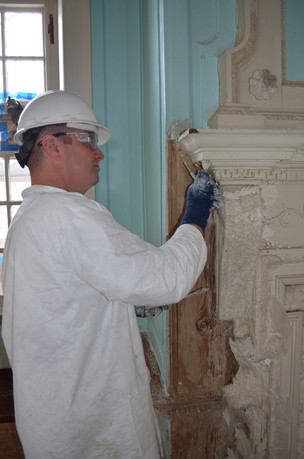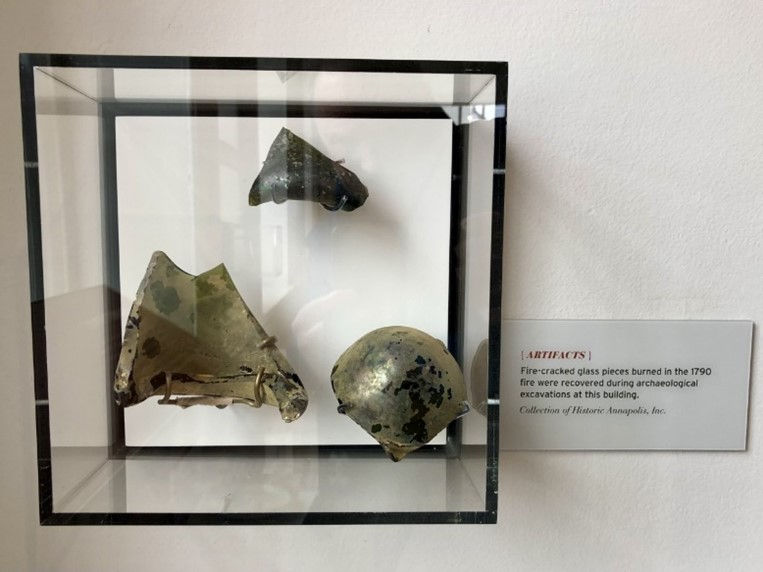Inside the James Brice House: Plaster and Finish Restoration
- HistoricAnnapolis

- Apr 21, 2020
- 4 min read
Updated: Dec 2, 2020
Working remotely, I miss interacting with the people at the James Brice House who are enthusiastically, scientifically, and methodically restoring this architectural treasure. The craftsmen conducting the restoration love to share new discoveries as they come upon them. Here is an update from the architectural conservators who are working on the raised plaster panels, cornice and mantels in the first-floor parlor and family drawing room and parlor. The conservation team is led by Chris Mills, with Brad Stewart and Kelsey Britt providing painstaking assistance.
Chris and his team joined the Brice house restoration project in 2017. Based out of New England, he and his coworkers apply academic research, conditions assessments, surface preparation, and conservation treatments to ultimately manufacture and install traditional hand-made finishes. These finishes recreate the composition and nuance of 18th-century finishes for museum settings. Following the Paint Analysis and any needed restoration work, Chris and his team hand-grind the specified pigments on a muller and slab (like a glass mortar and flat pestle) with a medium. They install the paint using traditional tools and techniques derived from historic treatises. Kelsey is an architectural historian and recent graduate from the University of Pennsylvania’s Historic Preservation Program, and Brad, plaster and finish specialist, has worked alongside Chris on landmark buildings for years. Another critical partner on this team is Erika Sanchez-Goodwillie, paint specialist, who has developed expertise in the manufacturing of oil and distemper paints with traditional materials, tools, and techniques. Their work takes them all over the country, from the Met in NYC to Montpelier in Virginia. We value their contribution in this process very much, and they seem to be as pleased to be here as we are to have them.
In the Drawing Room, the most ornate room in the James Brice House, the conservation team is removing as many as 16 layers of paint in order to articulate details in the mouldings that have been masked over time. They are sensitive to the fragility of the existing finishes and substrate (glossary time - the substrate is the original surface layer!); extensive paint removal erases the historical record and can harm the substrate. Past preservation work at Brice that dates to the 1950s, when the Wohl family owned the house, applied a far more aggressive approach to paint removal – burning paint off the wood wainscot below the chair rail with torches. Chris tells you a bit more about the wainscoting in the Drawing Room here:
Today, Chris and his team are selectively working with accumulated paint layers when in good condition and not distorting the intended detail. Where details are clogged, or repairs necessary, Chris and his team are applying a chemical stripper to expose the early strata of paint layers (before and after below!). Paint removal, combined with wet sanding and the application of artist tools, aim to preserve as much detail of the fragile composition possible.
In the Parlor, Chris reports that the rosettes and medallions are different from the rest of the cornice material, and that the limewash there did not bond completely to the substrate, and these surfaces are far more fragile. The rest of the cornice still has some of the limewash layers that have carbonated to a very hard crust and are well attached to the substrate. Here's Kelsey, sharing a bit about the challenges of working on the Parlor cornice:
Chris says, “By far, the most challenging part of this process is the paint removal from the Cornices. While other architectural elements throughout the house have been restored or replaced, the cornices were neglected – just painted over and over, completely clogging the detail. Attempts at paint removal likely found a very fragile and sensitive substrate. That's the hard part – much of the plaster detail is held in place by paint, particularly in the Parlor. The consolidation of the plaster happens during paint removal. It is slow and tedious. Prep work always takes so much time, but we will be happy to start the painting."
The results of the paint removal thus far have exceeded our expectations. Over the course of a few short months, the team was able to remove almost all of the cornice paint and uncover the original detail. The team has produced molds of key elements to reproduce what was damaged beyond repair. Their days have been filled with consolidation, repair, and localized paint removal. It is extremely detailed work. The team applies a zen-like quality to their craft, exposing the intricacies of these amazing features, methodically and meticulously.
Orlando Ridout IV speaks about this craft behind the original construction of these pieces in his book, Building the James Brice House, 1767-1774 (available for sale in our Museum Store once we reopen!), as it specifically relates to James Brice’s account book that details the construction of the building:

“There are a number of entries for payment for servant stucco workers. It is assumed that these specialized craftsmen were subcontracted from a local builder who had men trained in working
with plaster who were likely serving out their indentures. Plasterwork such as that at the Brice house involved three levels of skill. There was plastering of common walls in the regular way, and also the decoration of walls in the new fashion to represent large-sized fielded wood panels, imitated with plasterwork. Then there was the especially fine work involving the making and placing of pre-moulded plaster ornamental cornices in which the plaster (or fine grade stucco) was moulded in imported casts and the sections glued in place in the ceiling of the rooms and then finished with cutting tools so that no joints could be discerned from below. Fine plaster in casks, special trowels, and cutting tools were needed to finish the work.”
250 years later, our very own 21st-century craftsmen are honoring the work of those that came before with their meticulous restorations of the cornice, raised plaster panels, and fireplace surround and overmantel.
Historic Annapolis is immensely grateful for the generosity of The Helena Foundation who has provided financial support for this project. We will continue providing updates as the work progresses in the Dining Room and Front Hall. The conservation team is grateful to have the opportunity to continue their work on the Brice House restoration during these times of uncertainty.
Karen Theimer Brown Vice President, Preservation
Sources: Building the James Brice House, 1767-1774,” by Orlando Ridout IV, published by the friends of the Maryland State Archives, January 2013.






















I found that the proportions and detail of the main parlor are exceptional and create a stunning architectural space. I carefully noted the loss of detail and “slathering” of the mounding with paint over the decades and only hoped they could be restored. The photos illustrate nothing short of a miracle, the results will be stunning so that the magic of the space can be experienced again. Few structures have the spatial effects of this building, it is a rare experience indeed.